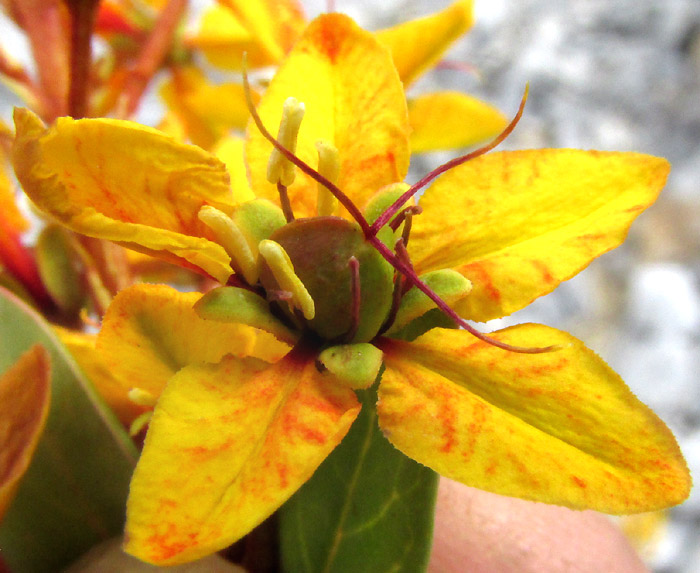Excerpts from Jim Conrad's
Naturalist Newsletter
entry from field notes dated June 1, 2023, taken about 150m uphill on NE-facing slope, above intersection of road from Hwy 120 to San Joaquín, with road to El Doctor; juniper and pine forest on limestone bedrock; elevation ±2425m (7950 ft); Eastern Sierra Madre mountains of east-central Querétaro state, MÉXICO, (N20.88°, W99.62°)
GOLDSHOWER

At the base of an upslope quarry's talus of limestone rock, the above knee-high, woody-based shrub provided a surprising burst of color in a drought-parched landscape of grays, tans and the dark green of junipers and pines. Up close, the flowers looked "typical," until certain details were noticed:

The above flower bears the classic 5 colored petals alternating with 5 green sepals, but then instead of 5 stamens, there are ten, though three of this flower's anthers appear to be missing. Note that the stamens are alternately tall or short. The green, oval ovary, the future fruit, is modestly three-cornered, and atop the ovary three purple styles diverge. The brown splotches appearing on the yellow petals is significant, because the splotches in this case indicate that the petals don't fall off soon after the flower is pollinated, as in most flowers. They persist a good while, but in a dried-up state; the brown splotches are a sign of what's coming. This, and a 3-angled ovary bearing 3 styles is an unusual combination in a flower. The Spurge or Euphorbia Family might have them, but what "euphorb" produces such large, yellow blossoms?

At the right it's seen that each flower arises on its own stalk, or pedicel, which is attached to the flowering head's central axis, the rachis. This marks a raceme-type inflorescence. Note that the calyx's sepals are of different lengths.

At this point my camera's last spare batteries died and I never achieved shots of the leaves and the nature of that reddish mealiness conspicuously covering the stem and inflorescence rachis and pedicels. At the left, an enlarged part portion of the top picture indicates that the leaves arise opposite one another on the stem, and their margins lack teeth or lobes.
Even without more vegetative details, the flowers' unusual configuration was enough to guide us to the family Malpighiaceae, which bears no commonly used English name, probably because its species overwhelmingly occur in New World tropical and subtropical regions. None of the family's species is well known to northerners, though the psychoactive and hallucinogenic brew known as ayahuasca is compounded from a giant South American vine of this family, Banisteriopsis caapi, and ayahuasca is becoming famous among psychedelic trippers.
Usually I recognize species of the Malpighiaceae Family by conspicuous, wartlike glands appearing singly at the base of each flower's sepals -- thus in pairs where the sepals unite. These glands occur on most New World Malpighiaceae species, such as the yellow ones on pink Barbados Cherry blossoms. Our bush's flowers bore no such glands, and that's another quirky feature of this species.
In our area of upland central Mexico, if you have a woody-based bush which is a member of the Malpighiaceae, it bears yellow flowers with 10 stamens, the stamens' filaments aren't hairy, and the bush's leaves bear tiny glands while its sepal bases have none, you have the genus Galphimia.
The Malpighiaceae isn't much studied in our region, but here we can look for maybe nine or ten species. Among these species, if your plant produces "persistent" petals, its ovaries are hairless, the flowers' pedicels are relatively long as seen above, and the vegetative parts bear no bump-like tubercles, you have GALPHIMIA GLAUCA. In English the bush is variously known as Goldshower, Shower of Gold, Rain-of-Gold, Spray of Gold, Thryallis, Galphimia and other such names.
Galphimia glauca bears so many English names because it's grown in many places both for its prettiness and it medicinal properties, and sometimes it escapes into the landscape, becoming invasive. By the way, that strange name Galphimia is a playful anagram of the genus Malpighia, on which the Malpighiaceae Family name is based. An anagram is a word or phrase formed by rearranging the letters of another word or phrase, ideally using all the original letters only once.
Galphimia glauca naturally occurs in the semi-warm and temperate areas throughout upland Mexico south to about Nicaragua, plus it's invasive in much of the world's warmer parts.
In traditional Mexican medicine, Galphimia glauca has long been used as a sedative, and clinical studies appear to support that use -- such as the 2007 study by A. Herrera-Arellano and others entitled "Efficacy and tolerability of a standardized herbal product from Galphimia glauca on generalized anxiety disorder. A randomized, double-blind clinical trial controlled with lorazepam." That study concluded that "... the effectiveness of this plant versus anxiety was demonstrated, and its behavior was similar to the one observed when lorazepam is used." Moreover, capsules containing 310 mg of dried aqueous extract Galphimia glauca were preferable to lorazepam because our plant did not cause excessive sedation, which lorazepam did, plus results were observed during the first week of usage, not 3-4 weeks, as was the case with lorazepam.